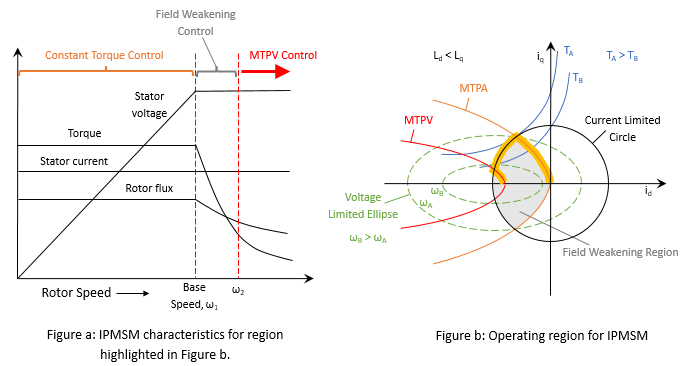PMSM Torque Estimator
Estimate electromechanical torque and power
Libraries:
Motor Control Blockset /
Controls /
Control Reference
Description
The PMSM Torque Estimator block generates electromechanical torque and power estimates to enable field-oriented control of a permanent magnet synchronous motor (PMSM). The block outputs mathematically computed electromechanical torque for the given motor parameters. To measure the torque value accurately, consider using a physical sensor.
The block accepts feedback values of d- and q-axis currents and mechanical speed as inputs.
The block generates these estimates from motor parameters specified using one of these methods.
Linear model with lumped parameters— Lumped parameters with d-axis and q-axis stator winding inductances and permanent magnet flux linkage.Non-linear model with D,Q-flux linkage LUTs— Nonlinear model with d-axis and q-axis flux linkage lookup tables.Non-linear model with Ld, Lq, and FluxPM LUTs— Nonlinear model with d-axis and q-axis stator winding inductances and permanent magnet flux linkage lookup tables.Input port based Ld, Lq, and FluxPM— d-axis and q-axis stator winding inductances and permanent magnet flux linkage values provided using separate input ports.
Equations
If you select Per-Unit (PU) in the Input
units parameter, the block scales down the internal parameters to match the
per-unit scale by default. You can also configure the block to convert the inputs to SI
units before performing any computation and convert them back to per unit values after
calculating the output by using the Allow scaled-down motor parameters with
CodeGen (higher precision with Fixed-Point data type) parameter.
These equations describe the computation of electromechanical torque and power estimates by the block.
or
where:
and are the d-axis and q-axis stator winding inductances (henry).
and are the d-axis and q-axis current (amperes).
ψm is the permanent magnet flux linkage (weber).
ψd and ψqare the magnetic fluxes along the d- and q-axes (weber).
is the number of pole pairs available in the motor.
is the mechanical speed of the rotor (rad/s).
For a detailed set of equations and assumptions that Motor Control Blockset™ uses for a PMSM, see Mathematical Model of PMSM.
Examples
Ports
Input
Output
Parameters
Extended Capabilities
Version History
Introduced in R2020a



